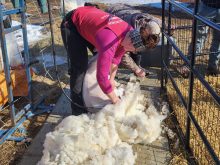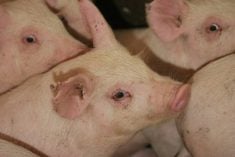The quest to unravel the mystery of E. coli bacteria grows more perplexing.
Researchers from many disciplines are searching for weapons against
E. coli 0157:H7, a deadly bacteria capable of killing people within a short period of infection.
E. coli contamination is often linked to “hamburger disease” and the beef industry is putting substantial research money into pinpointing its causes and sources.
Ongoing studies are looking at possible sources of infection, from feedlot water to feed rations. To protect human health, researchers say they must pinpoint the source of the disease.
Read Also

Charges laid after cattle theft
Saskatchewan RCMP lay two charges against a man after six cattle went missing.
“We have raised lots of questions as we go along,” said Agriculture Canada researcher Jim Miller.
Researcher Tim McAlister said efforts must be directed back to the cow-calf level because contaminants may have started there. Birds may have left infected droppings in grass and water, for example.
“If we are absolutely going to eliminate it, we have to focus prior to slaughter,” said McAlister, who works at Agriculture Canada’s Lethbridge Research Centre.
There are many strains of E.coli. It is present in the intestinal tracts of ruminants, ungulates, humans and birds. Some strains perform a useful function in the digestive tract. Others, like the 0157:H7 strain, can kill.
Pinpoint causes
Scientists know the deadly strain is seasonal and may be shed more frequently during stressful events like weaning or transport. It is suspected the animal’s environment may be a factor, but there is no solid proof.
This winter McAlister and others are looking at bacteriophages to combat harmful bacteria in the gut of sheep. Bacteriophages are types of parasites that multiply in a host bacterium. Research may determine whether they reduce the number of harmful bacteria without killing useful rumen microbes.
Graduate student Susan Buchko, also working at the Lethbridge research centre, is studying feed programs to control E.coli numbers, using three sets of feed trials.
One group of cattle received a grain diet of 85 percent corn, a second ate 85 percent barley and the final group received a 15 percent cottonseed and barley ration.
Fewer bacteria were found in the feces of those on the corn diet. The fecal pH level from corn was lower so there may be a connection with reduced counts of bacteria.
Researchers examined animals that had fasted and then changed rations from barley to silage. Bacteria levels increased with the feeding of alfalfa silage even though the feed itself tested negative for E.coli.
“Dynamics and other things at play make it hard to pinpoint what is having an effect,” said Buchko.
Jim Miller is conducting a feedlot water study. Results are expected next year. His team is looking at feedlot manure management and its potential links to water quality concerns.
Miller’s studies are the first to be targeted at southern Alberta. While he is not specifically checking for 0157:H7, his team has found a number of E.coli strains in samples collected at the Lethbridge centre feedlot.
They measured the quantity and quality of runoff water as it makes its way into the feedlot catch basin.
If research determines that bacteria can survive in the catch basin, it could have environmental implications for farmers who irrigate crops with this water.
Researchers are also measuring the permeability of feedlot floors to see if nutrients and bacteria leach into the groundwater. In addition, they compared straw and wood chip bedding materials.
Although pens are traditionally bedded with straw, some feedlots are beginning to use wood chips.
“Preliminary results show bedding makes no difference on the amount of bacteria present,” said Miller.
It was thought that phenols present in wood chips might kill bacteria but that does not appear to be the case.
However, wood chips do reduce the tag score, or the amount of manure and dirt on an animal’s hide. Less manure could mean less potential contamination when an animal goes to slaughter.
The persistence of bacteria in manure that has been spread on the land is another avenue of study. Researchers have learned composting at 60 degrees C for two to four weeks kills pathogens and weed seeds.

















